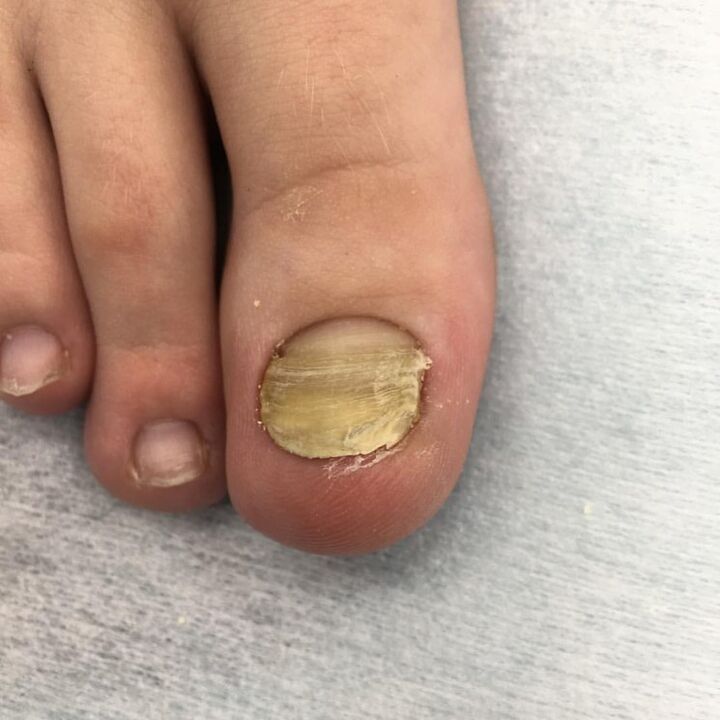Onychomicosis - damage to nails with fungal infection. The disease occurs in 5-10% of the population and among other nails lesions is about 30%.
The causes of onychomycosis
The infection of the feet nails plates occurs mainly in public bathrooms, saunas, swimming pools. The stairs with pathogenic mushrooms, who fall into patients with onychomycosis, fall on the floors, benches, bars, routes, rugs and waste. In conditions of high humidity, mushrooms not only can persist for a long time, but also multiply, especially on not painted benches and reticols, which makes them an intense source of infection.

Often, the onychomycosis is transmitted inside the family when using general shoes, towels, washing canvas, insufficient bathroom processing after washing, as well as due to rugs and rhetoricals in the bathroom. The damage to the nails of the hands usually occurs when it combs the outbreaks on the skin.
The occurrence of onychomycosis is facilitated by trauma of nails, in particular multiple (in athletes), compromised the blood supply to the limbs, serious concomitant diseases (diabetes mellitus, immunodeficiency states, blood diseases).
The onychomycosis is often found in people who have received antibacterial, corticosteroid and immunosuppressive therapy for some time. The injury of the nail plates takes place secondly: at the beginning the mushrooms influence the interdigital folds or the sole, then the nails.
Three types of onychomycosis are distinguished all over the world:
- Normorophic,
- hypertrophic
- Atrophic.
With a type of onychomicosis smooth scar, only the color of the nails changes: in their extreme departments, spots and stripes, whose color varies from white to guard. Gradually, the entire nail changes the color, keeping, however, shine and normal thickness.
With a hypertrophic guy, the changes in color, the nail loses shine, becomes opaque, thickens and deforms, partially destroyed, especially from the sides. Patients often feel pain during walking. A typical nail fungus is characterized by a opaque gray-brownish coloring of the affected part of the nail, its thinning and its refusal from the box; The naked area is covered with loose layers.
We treat the mushroom
Local antifungal agents are ineffective with damage to the nail plates. The processing with antifungal ointments, creams, solutions, paints must be preceded by removing the area mechanically affected nails or using keratolytic criminals.
Mechanical removal consists in cutting or cutting with bites of interested fragments of the nail plate.
The use of keratolithic patch in the treatment of omicomicosis allows you to soften the nail, due to which you can easily and painlessly remove the nail bed with an opaque or scissor scalpel.
As a keratolithic agent, a drug is used, which includes an ointment containing 8% of anti -fungary agent and 40% urea. The ointment is applied on the surface of the nail and covered with the sticker and bandage attached. After a day, the areas affected by the icydomicosis are clean. The procedures are performed daily until the affected nails are completely removed. In the future, when the affected nail is removed, the local ones are used: anti -pound paints.
- In the first month of treatment, a drug is prescribed for 6-8 tablets per day (750-1000 mg), in the second in the same dose on alternate days and then until the cultivation of plates for healthy nails, 2 times a week. It is taken in 3 doses with a teaspoon of vegetable oil. The duration of the treatment for mycosis is 4-6 months, with a mycosis of the feet-9-12 and even 18 months.
- Treatment with the preparation against the mushroom guarantees a cure only in 40% of patients. A combination with the removal of the nails increases the percentage of care. However, a large number of side effects, as well as a high percentage of recurrence of the disease, limit its use.

For a successful and secure treatment of the Wholenist, it is advisable to adhere to certain rules with systemic antifungal drugs.
First of all, the diagnosis should be reliable. The drug should not be prescribed if there is no laboratory confirmation.
After making the diagnosis, it is necessary to carefully collect an allergic story. If drugs or foods that cause allergic reactions or other events of intolerance are detected at the same time, then their intake should be excluded.
For the treatment period with systemic antifungals, it is advisable to limit the use of other drugs, with the exception of Vitale.
Prevention and treatment
In order to prevent gastrointestinal disorders, it is recommended to exclude products that cause flatulence from food during treatment: black bread, legumes, milk, cabbage.
Not a small importance is the selection of comfortable shoes both during treatment and after completion. Often, an improvement in the condition of the nail concerned is clearly correlated to the use of non -traumatic shoes, since the pollution of the tissues caused by the shoes can cause exacerbation or distal onychomycosis to the nail. Before starting the treatment, it is advisable to conduct a study on general and biochemical blood test indicators.
The control exams must be carried out the first time after 2 weeks, then 1 time a month. Control microscopy - 6 months after the end of the treatment. The identification of the mycelium of pathogenic mushrooms acts as an indication for a second course of treatment with preliminary surgical removal of the affected nails.
Prognosis for the treatment of omicomicosis
Despite the high percentage of treatment for patients with onychomycosis when using therapeutic agents, therapy with these drugs does not exclude the use of local antifungal drugs. The combination with the conservative and surgical removal of the nail plates reduces time to take anti -systemic anti -bactericides and increases the effectiveness of the treatment.
























